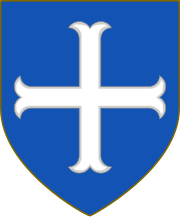The Duke of Portland
| Earldom of Portland | |
|---|---|
 
Bentinck arms: Azure, a cross moline argent
|
|
| Creation date | 17 February 1633 (first creation) 9 April 1689 (second creation) |
| Monarch |
Charles II (first creation) William III (second creation) |
| Peerage | Peerage of England |
| First holder | William Bentinck |
| Present holder | Timothy Bentinck, 12th Earl of Portland |
| Heir apparent | |
| Remainder to | Heirs male of the first earl's body lawfully begotten |
| Subsidiary titles | Viscount Woodstock Baron of Cirencester |
| Extinction date | 1688 (first creation) |
| Former seat(s) | Welbeck Abbey |
| Armorial motto | Craignez honte ("Fear shame") |
| Dukedom of Portland Extinct |
|
|---|---|

Heraldic achievement displaying arms of Bentinck (Azure, a cross moline argent) quartering Cavendish (Sable, three stag's heads cabossed argent attired or a crescent for difference), adopted 1802 when the Bentincks adopted the Cavendish name
|
|
| Creation date | 6 July 1716 |
| Monarch | George I |
| Peerage | Peerage of Great Britain |
| First holder | Henry Bentinck, 1st Duke of Portland |
| Last holder | Victor Cavendish-Bentinck, 9th Duke |
| Remainder to | the 1st Duke's heirs male of the body lawfully begotten |
| Subsidiary titles | Marquess of Titchfield; Earl of Portland; Viscount Woodstock; Baron Cirencester Baron Bolsover (1880 – 1977) |
| Extinction date | 30 July 1990 |
| Former seat(s) | Welbeck Abbey |
Earl of Portland is a title that has been created twice in the Peerage of England, first in 1633 and again in 1689. The title Duke of Portland was created in 1716 but became extinct in 1990 upon the death of the ninth Duke, when the Earldom was inherited by a distant cousin.
The title of Earl of Portland was first created for the politician Richard Weston, 1st Baron Weston, in 1633. He was Chancellor of the Exchequer from 1621 to 1628 and Lord High Treasurer from 1628 to 1635, and had already been created Baron Weston of Nayland in the County of Suffolk in 1628. This title was also in the Peerage of England. He was succeeded by his son, the second Earl. He served as Joint Lord Lieutenant of Hampshire. His son, the third Earl, was killed at the Battle of Lowestoft in 1665. He was unmarried and was succeeded by his uncle, the fourth Earl. He was childless and on his death in 1688 the titles became extinct.
The title was created for a second time in 1689 in favour of William Bentinck, the Dutch favourite and close advisor of King William III. He was made Baron Cirencester and Viscount Woodstock at the same time he was given the earldom, also in the Peerage of England.
The first earl was succeeded in 1709 by his son from his first marriage, Henry, the second Earl of Portland. He represented Southampton and Hampshire in the House of Commons. In 1716, he was created Marquess of Titchfield and Duke of Portland in the Peerage of Great Britain. His grandson, William Cavendish-Bentinck, 3rd Duke of Portland was a noted politician. He was Prime Minister in 1783 and from 1807 to 1809 and also served as Home Secretary and as Lord President of the Council. In 1801, he assumed by Royal licence the additional surname of Cavendish. Portland was the husband of Lady Dorothy Cavendish, daughter of William Cavendish, 4th Duke of Devonshire, and was a descendant on his mother's side of Henry Cavendish, 2nd Duke of Newcastle-upon-Tyne.
...
Wikipedia
